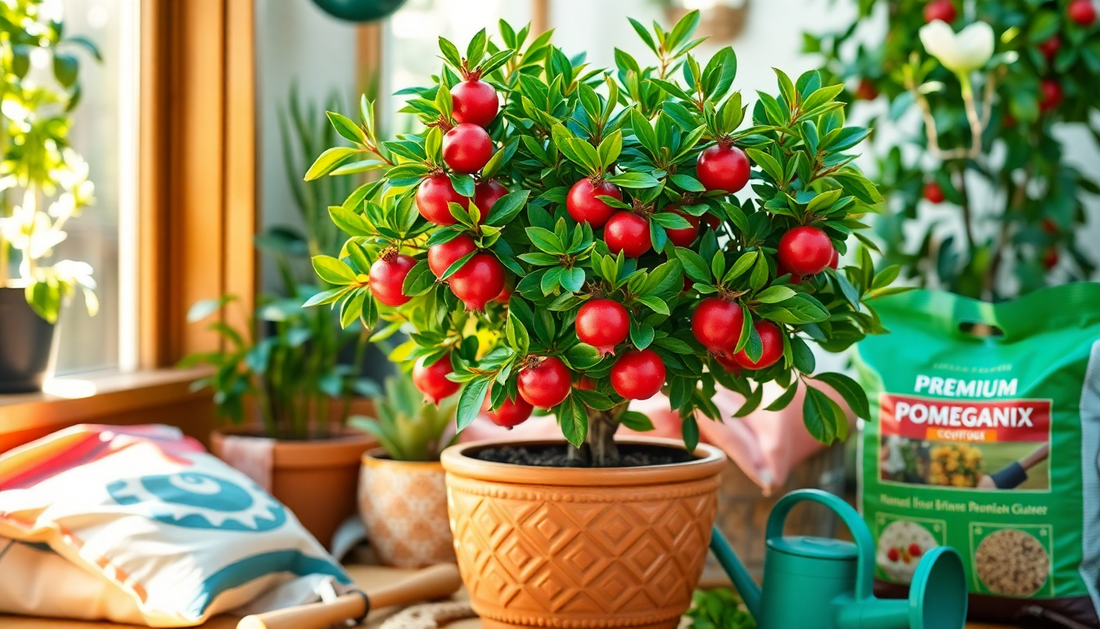
The Best Potting Mix for Pomegranate Trees Indoors
Pomegranate trees are a delightful addition to any indoor garden, offering vibrant foliage, stunning flowers, and of course, the tantalizing fruit. However, to ensure your pomegranate tree thrives indoors, it's crucial to provide it with the right potting mix. In this comprehensive guide, we'll explore the essential components of the best soil for pomegranate trees in containers, helping you create the perfect growing environment for your beloved plant.
Understanding the Needs of Pomegranate Trees
Pomegranate trees are native to the Mediterranean region and thrive in warm, dry climates. When grown indoors, they require specific soil conditions to mimic their natural habitat. The ideal potting mix for pomegranate trees should provide excellent drainage, adequate nutrient content, and the right pH balance to support the plant's growth and fruit production.
Drainage and Aeration
Pomegranate trees are susceptible to root rot if their soil remains waterlogged for too long. To prevent this, the potting mix must have excellent drainage and aeration properties. Look for a mix that contains a combination of organic matter, such as compost or peat moss, and inorganic materials like perlite or vermiculite. These components work together to create a well-draining, yet moisture-retentive, environment for the roots.
Nutrient Content
Pomegranate trees are heavy feeders and require a potting mix that is rich in essential nutrients. The ideal mix should contain a balanced blend of macronutrients (nitrogen, phosphorus, and potassium) and micronutrients (such as iron, calcium, and magnesium) to support the tree's overall health and fruit production.
pH Balance
Pomegranate trees thrive in slightly acidic to neutral soil, with a preferred pH range of 5.5 to 7.0. If the soil is too alkaline, the tree may struggle to absorb essential nutrients, leading to stunted growth and poor fruit quality.
Crafting the Perfect Potting Mix
Now that we've explored the key requirements for pomegranate trees, let's dive into the components of the best potting mix for indoor cultivation.
Organic Matter
Organic matter is the foundation of a healthy potting mix for pomegranate trees. It provides essential nutrients, improves soil structure, and enhances water-holding capacity. Some excellent sources of organic matter include:
- Compost: Well-aged compost is an excellent addition to the potting mix, as it introduces a wide range of beneficial microorganisms and slowly releases nutrients over time.
- Peat Moss: Peat moss is a highly absorbent material that helps retain moisture while improving aeration and drainage.
- Coco Coir: Coco coir is a sustainable alternative to peat moss, offering similar water-holding and aeration properties.
When creating your potting mix, aim for a ratio of 30-50% organic matter, depending on the specific components you choose.
Inorganic Materials
To ensure proper drainage and aeration, you'll need to incorporate inorganic materials into your potting mix. Some excellent options include:
- Perlite: Perlite is a lightweight, expanded volcanic rock that improves drainage and aeration.
- Vermiculite: Vermiculite is a mineral that helps retain moisture and nutrients, while also enhancing soil structure.
- Sand: Coarse sand can be added to the mix to improve drainage and prevent soil compaction.
Aim for a ratio of 20-40% inorganic materials in your potting mix, adjusting the proportions based on the specific needs of your pomegranate tree.
Nutrient-Rich Amendments
To ensure your pomegranate tree receives all the necessary nutrients, consider adding the following amendments to your potting mix:
- Slow-Release Fertilizer: Incorporate a slow-release, balanced fertilizer (such as a 10-10-10 or 12-12-12 formula) to provide a steady supply of nutrients throughout the growing season.
- Bone Meal: Bone meal is an excellent source of phosphorus, which is essential for root development and fruit production.
- Greensand: Greensand is a natural mineral that provides potassium, iron, and other micronutrients.
- Dolomitic Lime: If your soil is too acidic, add dolomitic lime to raise the pH and provide calcium and magnesium.
The amount of these amendments will depend on the specific nutrient content of your other potting mix components, so be sure to follow the manufacturer's instructions or consult with a local horticulturist for guidance.
Preparing and Maintaining the Potting Mix
Once you've assembled the perfect potting mix for your pomegranate tree, it's time to prepare and maintain it for optimal growth.
Mixing and Preparing the Potting Mix
- Start by combining the organic matter, inorganic materials, and nutrient-rich amendments in a large container or on a clean surface.
- Mix the components thoroughly, ensuring an even distribution of all the elements.
- Moisten the potting mix with water, but avoid oversaturating it.
- Allow the mix to sit for a few hours, then fluff it up before transferring it to the planter.
Maintaining the Potting Mix
- Monitor the soil moisture regularly and water your pomegranate tree when the top inch of the potting mix becomes dry.
- Replenish the potting mix with additional organic matter or slow-release fertilizer as needed, typically once a year or when you notice signs of nutrient depletion.
- Occasionally aerate the soil by gently loosening the surface with a fork or trowel to prevent compaction.
- Test the soil pH periodically and adjust it with dolomitic lime or sulfur if necessary to maintain the ideal range.
By following these guidelines, you'll create a thriving environment for your indoor pomegranate tree, ensuring it produces an abundance of delicious fruit for you to enjoy.
Conclusion
Providing your indoor pomegranate tree with the right potting mix is essential for its long-term health and productivity. By incorporating the right blend of organic matter, inorganic materials, and nutrient-rich amendments, you can create a soil environment that perfectly suits the needs of your beloved plant. With the proper care and maintenance, your pomegranate tree will thrive, rewarding you with a bountiful harvest of juicy, flavorful fruit.






No comments